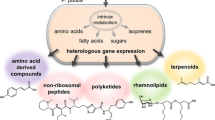Abstract
Pseudomonas pseudoflava GA3, an aerobic hydrogen-oxidizing bacterium, was characterized physiologically. The doubling time of autotrophically growing cells was 2.5 h for cells growing heterotrophically on sucrose it was 1.5 h; and for cells growing heterotrophically on fructose, succinate, lactate, glutamate, treahalose, glucose, and pyruvate it was about 1.6 h. Glucose and fructose were degraded via the Entner-Doudoroff pathway. 6-Phosphogluconate dehydrogenases (NAD or NADP-dependent) were not detected. Hydrogen did not suppress or inhibit the utilization of organic substrates. The specific hydrogenase activity was influenced by the growth conditions. An oxygen concentration of 20% (vol/vol) in the gas atmosphere provided conditions for continued exponential growth but diminished the specific hydrogenase activity. Cells contained a single membrane-bound hydrogenase; intact membranes were able to reduce menadion, ubiquinone Q10, methylene blue, phenazine methosulfate, and dichlorophenolindophenol. The hydrogenase was solubilized from the membrane fraction by treatment with 0.2% Triton X-100 and 10% sucrose, resulting in a yield of about 60% of total activity.
Similar content being viewed by others
Literature Cited
Aggag, M., Schlegel, H. G. 1973. Studies on a Gram-positive hydrogen bacterium,Nocardia opaca strain 1b. Description and physiological characterization. Archiv für Mikrobiologie88:299–318.
Auling, G., Reh, M., Lee, C. M., Schlegel, H. G. 1978.Pseudomonas pseudoflava, a new species of hydrogen-oxidizing bacteria: Its differentiation fromPseudomonas flava and other yellow-pigmented, Gram-negative, hydrogen-oxidizing species. International Journal of Systematic Bacteriology28:82–95.
Blackkolb, F., Schlegel, H. G. 1968. Katabolische Repression und Enzymhemmung durch molekularen Wasserstoff beiHydrogenomonas. Archiv für Mikrobiologie62:129–143.
Bowien, B., Schlegel, H. G. 1972. Der Biosyntheseweg der RNS-Ribose inHydrogenomonas eutropha Stamm H16 undPseudomonas facilis. Archiv für Mikrobiologie85:95–112.
Bowien, B., Schlegel, H. G. 1981. Physiology and biochemistry of aerobic hydrogen-oxidizing bacteria. Annual Review of Microbiology35, in press.
Bradford, M. M., 1976. A rapid and sensitive method for the quantitation of microgram quantities for protein utilizing the principle of protein-dye binding. Analytical Biochemistry72:248–254.
Gottschalk, G. 1965. Die Verwertung organischer Substrate durchHydrogenomonas in Gegenwart von molekularem Wasserstoff. Biochemische Zeitschrift341:260–270.
Groves, W. E., Calder, J., Rutter, W. J. 1966. Fructose diphosphate aldolase II.Clostridium perfringens, pp. 487–491. In: Colowick, S. P., Kaplan, N. O. (eds.), Methods in enzymology, vol. 9. New York: Academic Press.
Hanus, F. J., Maier, R. J., Evans, H. J. 1979. Autotrophic growth of H2-uptake-positive strains ofRhizobium japonicum in an atmosphere supplied with hydrogen gas. Proceedings of the National Academy of Sciences of the United States of America76:1788–1792.
Kluyver, A. J., Manten, A. 1942. Some observations on the metabolism of bacteria, oxidizing molecular hydrogen. Antonie van Leeuwenhoek Journal of Microbiology and Serology8:71–85.
Lee, C. M. 1978. Solubilization of membrane-bound hydrogenase ofPseudomonas pseudoflava, pp. 281–286. In: Schlegel, H. G., Schneider, K. (eds.) Hydrogenases: Their catalytic activity, structure and function. Göttingen Goltze.
Malik, K. A., Schlegel, H. G. 1981. Chemolithoautotrophic growth of bacteria able to grow under N2-fixing conditions. FEMS Microbiology Letters, in press.
Malik, K. A., Jung, C., Claus, D., Schlegel, H. G. 1981. Nitrogen fixation by the hydrogen-oxidizing bacteriumAlcaligenes latus. Archives of Microbiology,129:254–256.
Pedrosa, F. O., Döbereiner, J., Yates, M. G. 1980. Hydrogendependent growth and autotrophic carbon dioxide fixation inDerxia. Journal of General Microbiology119:547–551.
Pfennig, N., Lippert, K. D. 1966. Über das Vitamin B12-Bedürfnis phototropher Schwefelbakterien. Archiv für Mikrobiologie55:245–256.
Schink, B., Schlegel, H. G. 1978. Hydrogen metabolism in aerobic hydrogen-oxidizing bacteria. Biochimie60:297–305.
Schlegel, H. G., Kaltwasser, H., Gottschalk, G. 1961. Ein Submersverfahren zur Kultur, wasserstoffoxydierender Bakterien: Wachstumsphysiologische Untersuchungen. Archiv für Mikrobiologie38:209–222.
Schmidt, K., Liaaen-Jensen, S., Schlegel, H. G. 1963. Die Carotinoide der Thiorhodaceae. I. Okenon als Hauptcarotinoid vonChromatium okenii Perty. Archiv für Mikrobiologie46:117–126.
Schneider, K., Schlegel, H. G. 1977. Localization and stability of hydrogenases from aerobic hydrogen bacteria. Archives of Microbiology112:229–238.
Weiss, A. R., Schneider, K., Schlegel, H. G. 1980. Purification and properties of the membrane-bound hydrogenase ofPseudomonas pseudoflava GA3. Current Microbiology3:317–320.
Author information
Authors and Affiliations
Rights and permissions
About this article
Cite this article
Lee, C.M., Schlegel, H.G. Physiological characterization ofPseudomonas pseudoflava GA3. Current Microbiology 5, 333–337 (1981). https://doi.org/10.1007/BF01566744
Issue Date:
DOI: https://doi.org/10.1007/BF01566744




